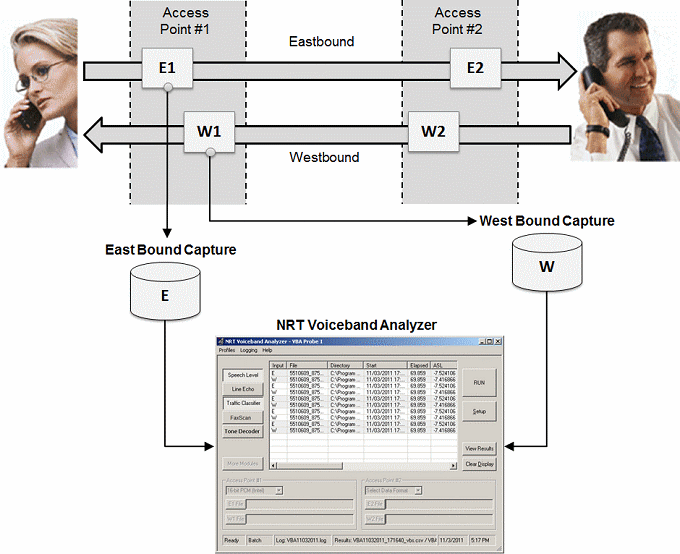Newsletter: GL Releases Enhanced Voice-Band Analyzer (VBA)
Welcome to a January issue of GL Communications' Newsletter providing information and insight into our product Voice-Band Analyzer (VBA) - An analysis tool for monitoring voice band traffic over VoIP, TDM, and Wireless networks.
Overview
Voice-Band Analyzer (VBA) is an analysis tool for monitoring voice band traffic
over VoIP, TDM, and Wireless networks. It can host a variety of analysis algorithms. Built-in algorithms include ITU-T P.56
Active Voice Level analysis, and Line Echo (Hybrid) analysis and Traffic Classifier. Other analysis modules
such as ITU-T P.561, P.562, and P.563 can be hosted as plug-ins.
The VBA application operates on captured files,
almost instantaneously, making it near-real time tool. It supports A-Law,µ-Law, 16-bit PCM (Intel), 16-bit PCM (Motorola)
and MS Wave file formats. The application has been designed to work with other GL tools such as PacketScan™ (for VoIP),
Call Capture and Analysis (for TDM), and GSM, TRAU, and 3G analyzers (for Wireless). VBA can also work with GL's 2-Wire
Voice/Data Capture products.

Some Important Features
- Near real-time non-intrusive analysis platform
- Supports 1, 2, 3, and 4-port signal data analysis
- Manual, batch, and automatic processing modes
- Accepts A-Law, µ-Law, 16-bit PCM (Intel), 16-bit PCM (Motorola) and MS Wave input data formats
- Hosts built-in P.56 Active Voice Level analysis, and Hybrid Echo analysis modules. Optionally Traffic Classifier analysis modules can be included. Other optional analysis modules are planned.
- Allows the grouping of files together into data sets and automatically routes file data to appropriate inputs using user-specified file naming conventions
- Measurements can be automatically input to a database for centralized applications.
- GL Call Capture and Analysis (CCA) rules are built into VBA.
To know more features of the product, please visit the Voice-Band Analyzer web page.
Operating Modes
GL's VoIP, TDM, and Wireless probes capture calls non-intrusively and feed them to VBA for analysis. VBA then instantly
detects the captured voice files, and instantly analyzes and stores the results as required. The real-time measurement data
collected by the probes can be output to a remote database by configuring appropriate VBA options. Outputs can be either
stored locally as *.csv files or sent to the central database over TCP/IP.
The VBA operates in three fundamental
modes:
- Manual:
The user specifies manually the files to be analyzed.
- Batch:
Using batch mode, users can analyze an entire set of assembled voice files in a folder or in subfolders at once. File naming conventions are used to group files and identify the appropriate input for each file. The results are recorded and stored in a destination folder in *.CSV format, where they may be viewed with spreadsheet applications such as Microsoft® Excel.
- Automatic:
This is similar to Batch processing, except the process continues indefinitely until the user manually stops the execution. The specified folders are continuously scanned for the arrival of new files. The results are recorded and stored in a destination folder in *.CSV format, where they may be viewed with spreadsheet applications such as Microsoft® Excel.
Brief Description Analysis Modules:
- P.56 Active Speech Level Parameters & Output Fields
The active speech level is measured in accordance with P.56 Method B. All the parameters have fixed values. The Active Speech Level is reported either in units of dBm (P.56 standard) or as dB relative to a full-scale sine wave (PCM standard).
- Line Echo Model Configuration Parameters & Output Fields
Line Echo has two classes of variable parameters: Echo Path Model and Double-Talk Detection parameters. Echo Path Model parameter allows setting values for 'Tail Length' and 'Tail Offset', while, double talk detection (DTD) allows raising or lowering the ON Sensitivity and OFF Sensitivity. The application displays the echo parameters such as ERL (dB), Echo Delay (ms) and Echo Dispersion (ms).
- Traffic Classifier Parameters & Output Fields (Optional Module)
The Traffic Classifier algorithm allows setting signaling bits idle code values for A-Law, u-Law, and PCM-16. In addition, it provides VBA the ability to detect DTMF, MF, MFR2-fwd, MFR2-bkwd digits, and Tones (Dial/Ring/Busy). Traffic Classifier algorithm allows VBA to choose to display the amount of Fax/Voice/Digits/Tones/Silent types of traffic present in the network and generate corresponding reports.
 Back to Latest News Page
Back to Latest News Page